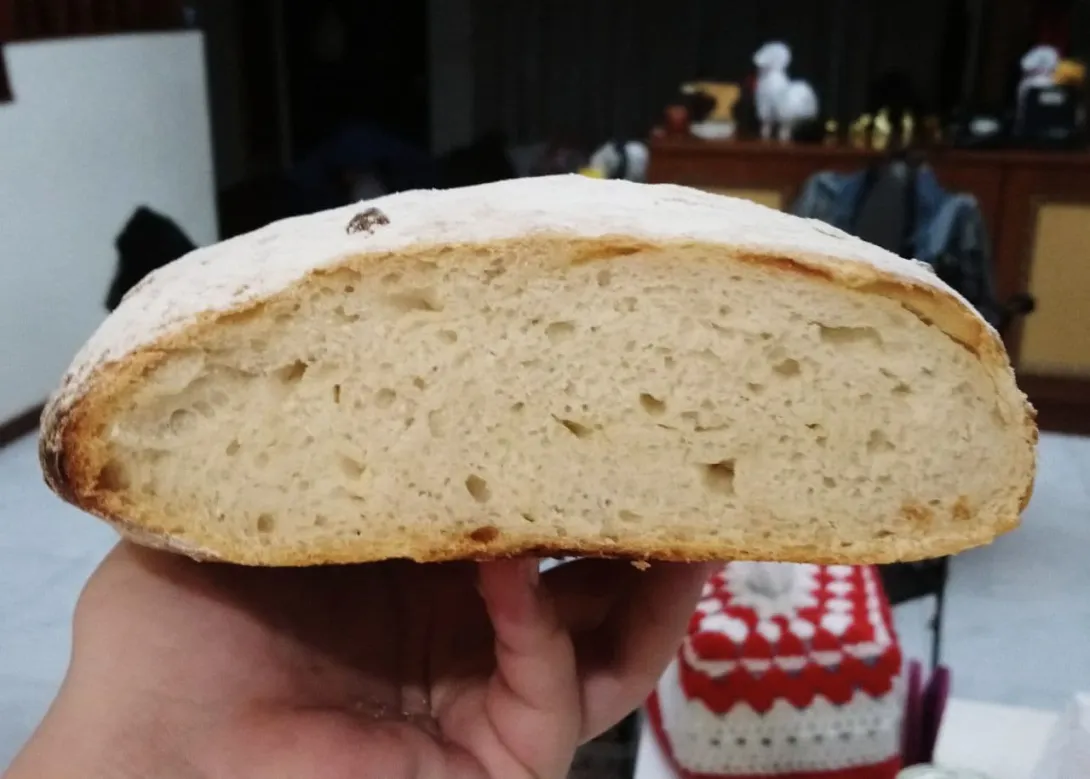
Hi, would like to get some views on the crumb, crumb colour, crust, and maybe smell of my recent bake.
Thoughts about the bread:
- Weight: Bread felt heavy. It was rather dense.
- Texture: It's like a harder version of white bread. When hot (or toasted) it's soft enough but not as soft as white bread.
- Crust:
- The sides were more crusty than the top and bottom. Can see the darker parts.
- Think the top wasn't as crusted because of the rice flour?
- The bottom did stick to the baking tray but I think it might have been the mozzarella cause it didn't tear when I dislodged it.
- Crumb:
- I honestly have no idea how to describe the colour of the crumb but is it a normal colour? I used unbleached bread flour and like 10g of semolina only.
- This would be described as a tight crumb right? What are your thoughts about the aeration? How can I achieve a much more open crumb?
- Rise:
- After shaping, rested for 45 mins and it expanded somewhat.
- It did not rise any further in the oven.
I was aiming for 80% hydration but I couldn't handle the dough so added a lot more flour in during kneading and folding. So I'm estimating it's a 75% hydration instead. Also, I did give up at the end because I didn't have time left and I didn't want the dough to be sitting in the fridge for a week.
Anyway, the recipe and steps are listed below:
Recipe: [ Yeast refers to Fleischmann's ActiveDry Yeast and I used 1 1/4 tsp in total; % isn't my strongest suit so I might have gotten the values wrong :') ]
Steps: [ All kneaded by hand. I live in SEA so the weather is hot and humid. ]
Notes about the preferment:
- It sat in the fridge for 14 hours and developed a stiff crust that I didn't cut off when adding to the main dough. Should I have cut it off?
- Took it out of the fridge and sat on the counter for a good 1 hour before starting the main dough. When I opened it, it had a sour and slight alcohol smell.
- Question: Should I not have used it after all? The baked bread tastes fine.
Notes about the main dough:
- I was going to leave it overnight on the counter to proof (room temp. approx. 29 degree Celsius). But after 3 hours, it had tripled in volume and had 2 large bubbles on the surface.
- Jiggled the bowl slightly and it started degassing itself. So opened the clingwrap to let the gas out and got hit by a strong sour, acidic? wave.
- Question: Usually my 3 hour rests on the counter for focaccia at 28-29 degree Celsius don't develop such smells. Was it because of the preferment?
I use the word "dense" for the crumb in the photo.
I see far too much time in the second table showing the procedure. The dough is overproofed, as shown by the photo, the fact it didn't give oven spring, it didn't rise much during proofing and the very, very long time to mix, ferment, retard, shape and proof the dough.
Try: mix, 3 hour room temperature ferment, shape, 1 hour proof, then in the oven.
Bread is incredibly forgiving once you get "in the zone". You need to get in the zone first. With much kindness and encouragement, this bread isn't there.
Thanks for the feedback!! ?
I was trying to get the flavour to develop hence the long cold retard. But ya... It was definitely longer than I had initially intended. ? But what do you mean by overproofed? What are the telltale signs of overproofed dough?
Dense crumb, little to no oven spring are indicators. You also said you used "alot more flour" in the kneading step, and estimated the hydration at 75%. I think you may be generous with your estimate, and you might have ended up in the low 70s or into the 60s with hydration. Lower hydration is also related to dense crumb. Time to try again, using a known reliable recipe, and sticking to it precisely in every respect.